We did some testing with a small inverter to see how it would work with our V60 universal laptop battery. This setup allows you to plug some regular “wall plugs” into a solar setup like you would in your home. However, we don’t recommend it unless it is absolutely necessary:
- there is most often a way to connect directly from the battery to the device without an inverter
- the inverter wastes a lot of power
- it doesn’t work in many cases (you’re not going to plug your tv into the V60 and run it)
In this post we’ll show you how select and connect an inverter that will give you the option to operate those LOW power devices that would otherwise require juice from the grid.
When choosing a DC to AC power inverter, close attention must be paid to power, as in Watts. If the Watts delivered by your inverter is more than the power rating on the power supply, you may damage your devices. Let’s have a look at the V60 power specifications, shall we?
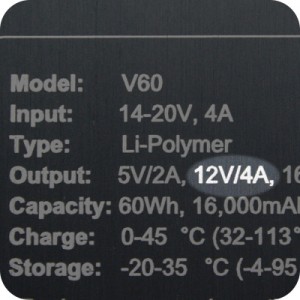
The maximum ratings for the V60 are printed on the back and given for all the outputs: 5V USB and the 3 higher voltage 12/16/19V settings. We’re interested in the 12V setting and the maximum current or amps. It’s listed as “12V/4A”, or 12 volts and 4 amps. To get Watts from these numbers, we simply multiply volts by amps. That gives us a maximum power output from the battery of 48 Watts at the 12V setting (12v x 4A = 48W).
Because there may be loss due to the inefficiency of the circuits involved, we never want to match the power setting of our inverter to the maximum output of the power supply. Doing so would result in the inverter drawing more power from the battery than it can supply, which would cause the battery to shut down as the over discharge protection is triggered. A conservative choice for an inverter would be this 30 Watt variety by Duracell available on Amazon.com.
For this post, though, we decided to see what would happen when we do exceed the maximum power rating of the V60 and how the system responds. We use a this 150W inverter by Wagan Tech with our V60.
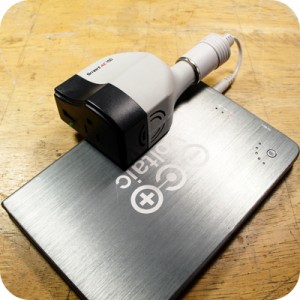
To connect the DC to AC inverter to the V60, you’ll need to purchase an optional 5.5×2.5mm to DC Car Charger Socket from our adapter page (in the Optional Computer Adapters section).
- How to connect the inverter to your V60
- First set the voltage on the V60 to 12V (16V will not work)
- next connect the socket to the output
- then connect the inverter to the socket
- finally connect your device and power it on
Efficiency is important so we got our meters out and measured the power use of all the components.

We used a PWRcheck by West Mountain Radio modified with input connections compatible with our products. The power loss from this device is already .88W.
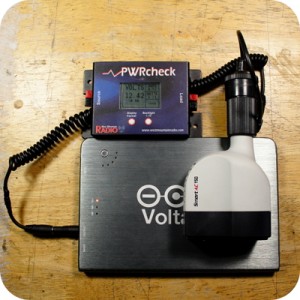
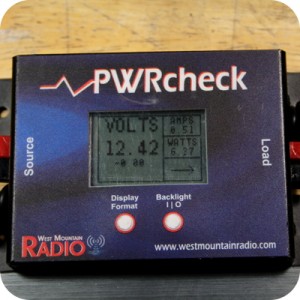
Upon connecting the inverter, we see an immediate 5.49W increase (6.37W drain total). This is the power necessary run both our the test equipment and power inverter’s electronics. This loss is added to any inefficiencies that might be present elsewhere.

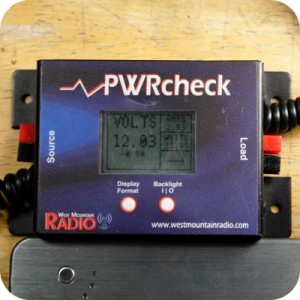
At 12V the inverter was able to power a 27W EcoSmart CFL (100W incandescent equivalent light output). The power drain was more like 31.85W. Assuming that the CFL was drawing a full 27W, the total system efficiency is close to 84% (27W / 31.85W). Not bad, but you might get better performance running LED lighting directly from DC output of the V60 where something like this 10W bulb will get you 50W equivalent halogen output. The trade off is initial cost of the bulbs and fixtures for more light, longer bulb-life and fewer components in the power chain.
Connecting a second 27W CFL to inverter caused the system to turn on and off rapidly. The inverter has a circuit that protects the battery from over discharging and turns off when the input voltage drops too low. Voltage output of the V60 decreases with increased power draw, but recovers once the inverter turns off. Once the V60’s voltage recovers, the inverter kicks on, repeating the cycle.
When testing a MacBook 15 using the AC power adapter, the system completely shut down. The power consumption from the MacBook’s AC adapter was so great that it sent the V60 into short-circuit protection.
Conclusions:
You’d only use the inverter in a case where you would need a direct connection from an AC source and no alternative DC powered device were available (as in the case of the CFL, but even here you’d be better off finding LED lighting that ran from USB). In terms of hooking up other things to power from the inverter that you might want to use in an off grid situation, we couldn’t even get the system to power my 300 series Dremel tool, which actually operates at about 145W, so it’s easy to over do it on the power draw from grid powered devices. Set realistic expectations when resorting to an inverter. Powering a mini fridge or TV using an inverter and V60 isn’t going to happen, but as we demonstrated, it is possible to have a good light source in a pinch.

So would the lack of a consistent stream of power explain why some devices have issues when trying to charge up some models of iPhones via USB? Some devices are real finicky and the power seems to start-stop-start-stop. Especially with the iPhone 3GS, this has been more prominent than the newer iPhone 4S.
I love these little demos. Interesting, plus a great review on the fundamentals of electronics.
A couple of questions, though –
If the V60 at 12V has a max wattage of 48W, it is initially recommended to use something like the Duracell 30W inverter, but you then use a 150W inverter. Why did you do this? From the article, it sounds like, be conservative on the inverter wattage, but then you go the other direction.
Why will only setting the V60 at 12V work for this experiment? Why won’t 16V or 19V work?
For this posting, it would be helpful if you could post what the readings on the PWRcheck say…some of the numbers on the displays are difficult to read.
So what would happen if one tried to power up a 100W bulb? Would it even turn on? Or would it just be dim?
We use a 150W inverter because we’re interested in seeing how our batteries perform at their limits. We recommend the 30W inverter because this is something that will be able to deliver the best workable solution.
The inverter is designed to operate from 12V systems. If there is too much or too little voltage on its input, the device shuts down. This is a limitation of the inverter itself.
Exceeding the output of the V60 will cause it to shut down. When approaching the max power output of the V60, the voltage drops, which may cause the output of the system to turn on and off rapidly.
Thanks for your questions.